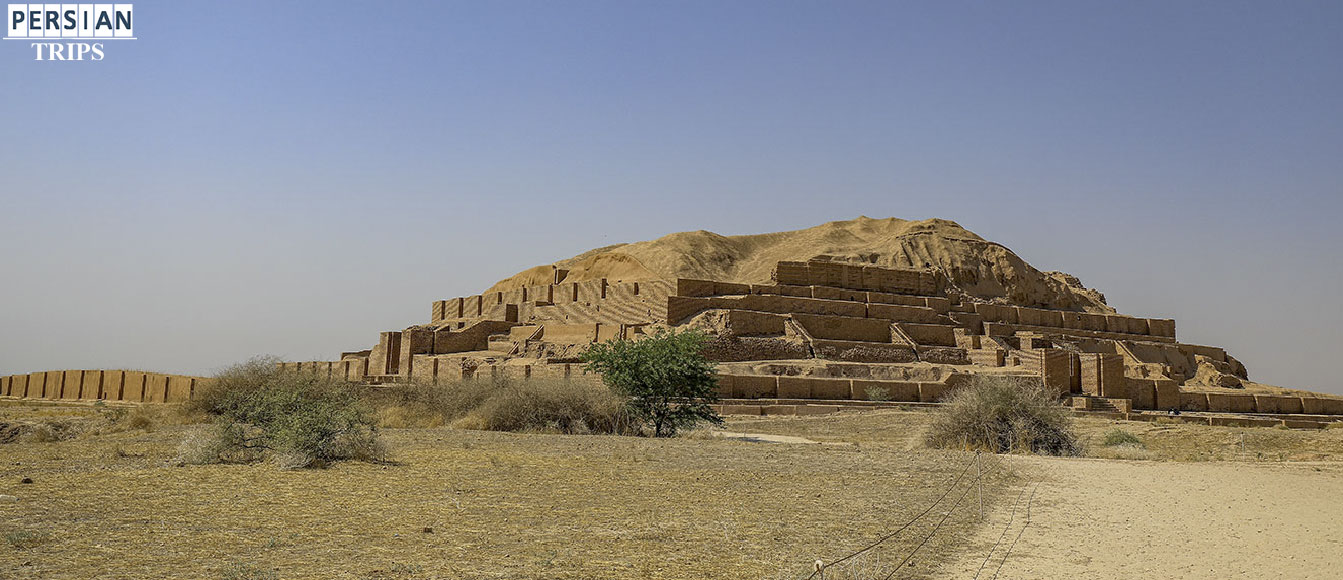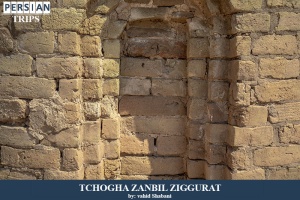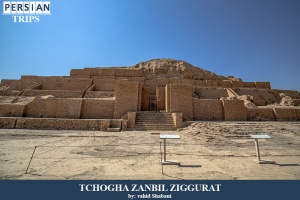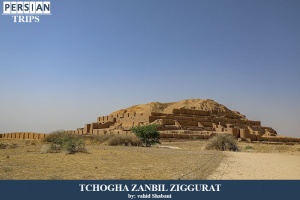Shush Chogha Zanbil Ziggurat

The first UNESCO World Heritage Site of Iran in 1979, the oldest religious place of worship in Iran and the largest remaining ziggurat in the world is Tchogha Zanbil Ziggurat of Susa.
In this article, we will learn about the different dimensions of this extremely important and historical ancient heritage.
Where is Tchogha Zanbil Ziggurat?
The history of the Middle East shows us that Khuzestan region is one of the oldest human settlements and Susa, one of the oldest civilization centers in the world, is the most important among its cities. Tchogha Zanbil Ziggurat is located 2 kilometers from Dez River among 4 cities of Shush, Shushtar, Ahvaz and Dezful. To reach the Ziggurat of Tchogha Zanbil by road, you can take the route from Shushtar to Haft Teppe or the secondary route in the road from Dezful to Ahvaz.
What does Ziggurat and Tchogha Zanbil Mean?
Ziggurat is an ancient word in Mesopotamian languages such as Akkadian, Sumerian, Babylonian and Elamite, meaning "tall structure" or "elevated place". Of course, the current form of the word ziggurat was first written by the famous French archaeologist Roman Ghirshman in his book. But why high? Mesopotamia is such a low and flat land with very few high areas that mountains or any tall natural phenomena are rarely seen in the Tigris and Euphrates plains. For this reason, the civilizations of this region built their religious places of worship in many floors in the second and third millennium BC in order to be closer to the sky and the gods.
Tchogha Zanbil is a Kurdish and Lori word, meaning "basket-shaped hill". The reason for this name lies in the basket shape of the temple before digging and coming out of the ground; unfortunately, there are very few photos left from that time.
History of Tchogha Zanbil Ziggurat
The civilization of Elam was a multi-god civilization and each god was considered the patron of one city. The city of Susa had a special position as the capital; therefore, in 1300 BC, Untash Gal or Untash-Napirisha , the greatest king of Elam, built Tchogha Zanbil Ziggurat to honor and worship Inshushinak (the patron god of Susa and the great god of the Elamites). Gradually, houses and facilities were built around this temple and it became a big city. He called this new city " Dur-Untash" which means the city of Untash. Untash Gal's purpose was to immortalize his name among the kings of Elam and also to make Susa central among all the cities of Mesopotamia.
This city was destroyed and abandoned due to the devastating attack of Ashurbanipal, the emperor of Assyria. There is no important information about this building in the historical texts until the discovery of the temple (late 19th century AD). But we know that over time it sank under a pile of soil and kept the remaining building safe from erosion.
But the story of its discovery is very interesting; it goes back to 1890. Jacques de Morgan, a famous French geologist gave information to the Anglo-Iranian Oil Company according to the Muslim writings and geological researches, in which the existence of oil reservoirs around Susa was mentioned. After about 50 years of exploration to discover oil, an Irish engineer of the aforementioned oil company, found one of the bricks of the Tchogha Zanbil Ziggurat quite accidentally and reported to the company. This discovery was the beginning of excavation of Tchogha Zanbil by Roman Ghirshman, and finally, its building, which was completely excavated by 1964, had a deep impact on the world's knowledge of the historical background of Iran.
Architectural Features of Dur-Untash City and Tchogha Zanbil Ziggurat
The city and all its buildings, in an area approximately 1300 meters long and approximately 1000 meters wide, were built from local soil and three types of clay: Raw clay, brick and clay that is mixed with beaten or broken baked clay. More than 5000 bricks of the temple have inscriptions, the text of which is mostly related to the curse on the destroyers of the building. The mortar used in the structures is clay, mineral bitumen and plaster, and stone is used to connect the doors to the walls and the heel of the doors to lock the doors, and sometimes to prevent water erosion and also as the face of the bricks. Simple Cement has been used to cover rooms against moisture. This city is surrounded by three mud walls, which have places of worship, palaces and palace-monuments. The central fence with the Ziggurat and large courtyards with different sizes, shapes and arrangements are about 520 meters long. This fence has 7 gates in different directions; the largest of these gates are located in the southeast (royal), southwest (chariots), northwest, and northeast directions. The northeast courtyard is the largest and the southwest courtyard is the smallest. The northwest and southwest courtyards are rectangular and the northeast and southeast courtyards are circular. Inside the courtyards of the central fence and in the southeast of it, brick platforms for the sacrifice have been built. In front of each gate, a place of prayer was built, out of which only 4 places of prayer have been excavated. The shrines of all the Elamite gods are also located in the holy neighborhood.
But the Ziggurat, built in the central wall of the city, is dedicated to the gods; the area of each floor of this building is less than the lower floor. Unlike the Mesopotamian ziggurats where each floor was built on top of the next floor, all the floors of the Tchogha Zanbil Ziggurat started from the ground level. Ghirshman estimated that this temple was 5 floors with a height of 52 meters, which was built in two separate stages. First, the first floor is 8 meters high with 28 rooms and a staircase to access the higher floors and then the next floors. On the last floor, like the similar Babylonian buildings, there was the temple of Inshushinak, which was destroyed in the excavation. The façade of this temple was decorated with square blue and green glazed plaques and blue and green glazed bricks with a little gold and silver glaze. Today, only two and a half floors of this temple with a height of 25 meters remain.
The clay building of Ziggurat of Tchogha Zanbil shows that the Elamites were aware of the pressure of clay volumes on each other in the second millennium BC and took it into account in their accurate calculations because no soil settlement or displacement has been observed, even in one brick of the building. The central core of the ziggurat is raw clay, which is covered with a 2-meter-thick brick veneer to protect the building from wind and rain.
This temple has sewage and water supply facilities that direct the rainwater outside with horizontal and vertical brick ways. Several gutters have been responsible for collecting the water of the stairs. It is interesting to know that Elamite engineers could not dig a canal to solve the needs of the city due to the lower level of Dez River, which is located 2 kilometers away from the city. Instead, they have provided water to the city by digging a 50-kilometer aqueduct from Karkheh River!
The Future of Tchogha Zanbil Ziggurat
Unfortunately, the discovery and emergence of the building from under the soil exposed it to the erosion of wind and rain, and if the necessary protections are not carried out, Tchogha Zanbil ziggurat will turn into a mound of dirt in the coming years.
Undoubtedly, Tchogha Zanbil Ziggurat is a world heritage for the entire history of mankind. An excellent example of ancient architecture and a sign of human civilization. Do not hesitate to visit it !!!
Tags: Khuzestan Province, Shush TChogha Zanbil Ziggurat, Ziggurats in Iran, khuzestan Attractions , UNESCO World Heritage Sites, Iran Historical Attractions














